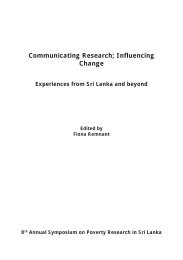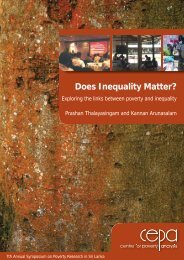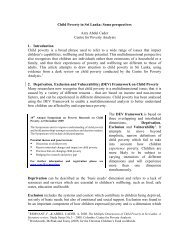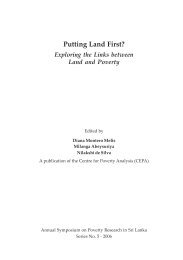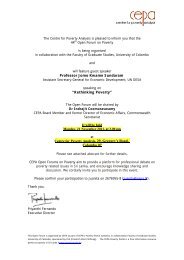Involuntary Displacement and Resettlement â Policy and ... - CEPA
Involuntary Displacement and Resettlement â Policy and ... - CEPA
Involuntary Displacement and Resettlement â Policy and ... - CEPA
- No tags were found...
You also want an ePaper? Increase the reach of your titles
YUMPU automatically turns print PDFs into web optimized ePapers that Google loves.
still remained in transitional shelter at the end of 2007 because of local hostopposition to their resettlement. A church bought a piece of l<strong>and</strong> for adonor-driven scheme <strong>and</strong> built houses for them in Dankotuwa, north ofColombo. Once it was discovered that Tamil families were moving into thearea, local residents protested. The houses were reallocated to localSinhalese families. At the time of research, these Tamil families were waitingfor another piece of l<strong>and</strong> to be purchased <strong>and</strong> construction to begin anew.3 Conclusion <strong>and</strong> RecommendationsTsunami resettlement is embedded in complex social <strong>and</strong> political relations.This section shows how <strong>and</strong> why some families have been left behind intransitional shelter even three years after the tsunami. These reasonsinclude male bias/discrimination, the inability to find a suitable piece of l<strong>and</strong>,poor negotiation skills, opposition from local ‘host’ communities toresettlement, or delays in fund disbursements to build houses. In somecases, frustrations with the self-settlement have become so high thatfamilies have rejected the package altogether.As women <strong>and</strong> the urban poor tell their stories of repeatedly filling outforms, being told to come back later, or being cheated by l<strong>and</strong>owners, wesee how their social exclusion takes place (Abrams, 1988), how structures oflocal power, authority <strong>and</strong> control (in this case between citizens, the GN <strong>and</strong>DS) are maintained (Nugent, 2001), <strong>and</strong> how these sets of practices (denial,delay <strong>and</strong> eviction threats via cutting off services) produce the state effect(Mitchell, 1999). Overall, the relationship between the Sri Lankan state <strong>and</strong>Colombo’s tsunami displaced-families left behind is passive aggressive. Localgovernment authorities seem unable or uninterested in providing coherentexplanations to families about why compensation is late or not forthcoming 18 .Local officials exert power in threats of eviction <strong>and</strong> in the ways that theyrefuse to take any responsibility for their inability to serve citizens in movingout, instead transferring the ‘blame’ onto the families, charging them withexpecting more then they deserve. Women <strong>and</strong> others among the urbanpoor face exclusion <strong>and</strong> discrimination not only from these representativesof the state, but also from other groups in Sri Lankan society.18All of my requests to speak to Grama Niladharis in Colombo about post-tsunami programmingwere denied. Discussions with GNs took place in the Batticaloa District <strong>and</strong> have been writtenabout elsewhere.199



